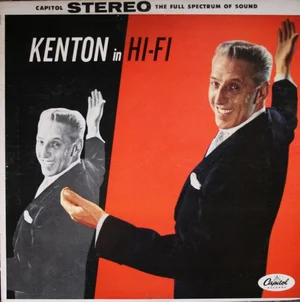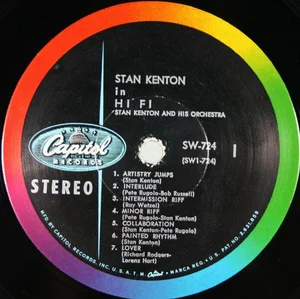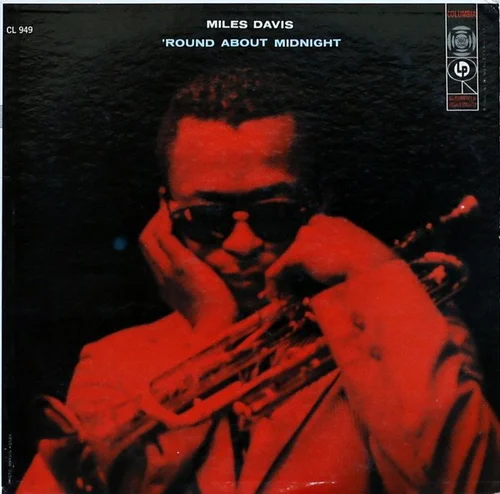
PREAMBLE
Welcome to my series Treasures from the Vinyl Vault. In it, I will feature select gems from my approximately 12,000 ever-growing vinyl collection, accumulated over a 45-year period and counting*. This will not be your typical “Greatest Of All Time” list, but more of a guided tour, occasionally accompanied by an anecdote or two, of the singles and albums in my collection that are most precious to me, both for their historical value and the impact they’ve had on my musical journey. In order to cover the greatest number of them, I will not go into much detail about the record’s history or its sound quality—for those aspects I invite you to visit my Top 500 SuperSonic List at https://soundevaluations.blogspot.ca/.
Records will be presented in chronological order based either on their recording date or original release date, and not reissue date—which means, for example, that Miles Davis’ iconic Kind of Blue album will be featured only once, in 1959, despite its many remasterings and repressings over the years. Also, all pressings are US ones unless specified otherwise. If ‘mono’ is not indicated, then consider it stereo or that the stereo version of it is my de facto choice of the two. Let’s continue, shall we?
22- Elvis Presley – 24 Karat Hits!.
Analogue Productions, RCA Victor – APP-2040 (tracks A1 to B5, mono; C1 to F4, stereo) (2010), 3×45 rpm. Genre: rockabilly, rock and roll, blues, rhythm and blues, ballads, gospel, country.
In my teens, I used to dislike everything Elvis, finding The King, kitsch–especially so in his later years, packing pounds under tight white jumpsuits. Later on, I better understood his place in history and the immense impact he had on many rock artists I respected. If, like me, you occasionally enjoy and appreciate him but are not a die-hard fan, this 24-hit compilation is made for you. With its songs presented in mostly chronological order on one tripple-45 rpm LP set and spanning his RCA Victor period from January, 1956, with “Heartbreak Hotel” through “Suspicious Minds” from August, 1969, 24 Karat Hits!, remastered and cut by George Marino at Sterling Sound in New York for Analogue Productions, is perfect for the person who strictly wants Elvis’ top hit singles delivered in outstanding sound quality. To maximize sound fidelity, Marino—like Kevin Gray and Steve Hoffman in 1997 [DCC LPZ(2)-2040]—went to great lengths to use the true mono, two, and three-track tapes, instead of cutting from second or third generation tape copies. Many music lovers may be astonished to hear how well recorded the King can sound on a good transfer played back on a quality sound system. In addition to Elvis’ commanding vocal presence and near-surrealistic imaging, what really strikes the senses here is the rendering of the back vocal quartet The Jordanaires, with its almost spooky-sounding realism. Renowned engineer Bill Porter and Thorne Nogar share most of the recording credits for their work across several studios, including RCA-Victor Studio B, Nashville, TN; RCA-Victor East 24th Street Studio, New York City, NY; Radio Recorders Studio B, Hollywood, CA; American Sound Studio, Memphis, TN, and MGM Scoring Stage, Culver City, CA. With the exception of the first two tracks, the tonal balance is spot on and reaches down deep as well as up high. The recording offers incredible transparency and a heightened sense of instrumental and vocal presence. Owning the earlier, excellent-sounding DCC double-33 rpm version, I can attest that this 2010 Analogue Productions remastering easily surpasses it on all fronts.
23- Rosemary Clooney and Duke Ellington and His Orchestra – Blue Rose.
Columbia – CL872 (mono) (1956, May), 33 1/3 rpm. Genre: traditional pop, ballad, big band, vocal jazz, swing.
The first time Rosemary sounded a bell in my mind was via my Dad, who was fond of big band music, traditional pop, and jazz. He’d often watch The Lawrence Welk Show on weekends, where some of these music styles mingled alongside what he called, “boring, corny stuff”. This album represents Clooney’s debut but also Duke’s return to Columbia after a three year stint at Capitol Records. It is a fine album featuring eleven tracks alternating between sultry ballads and swingin’ numbers. Duke and Billy Strayhorn’s signature writing and arrangements are a perfect fit for Clooney’s vocals. I don’t have an original ‘six-eye’ copy but rather a first-press Canadian mono one which sounds quite good. Interestingly, while the orchestra was recorded in New York in January, 1956, Clooney sang her parts two weeks later in Los Angeles in what was then an innovative new practice and is now the norm—overdubbing.
24- Stan Kenton – Kenton in Hi-Fi.
Capitol Records – W-724 (mono) (1956), SW 724 (stereo) (1959), 33 1/3 rpm. Genre: progressive jazz, big band, swing.
American bandleader, pianist, composer, and arranger Stan Kenton was, without doubt, my dad’s favorite music artist. Much less commercial than big band counterparts Benny Goodman, Glenn Miller, and Harry James, Kenton prioritized progressive forms of jazz over popular dance-oriented big band arrangements. Closer in form to Duke Ellington, Kenton navigated the ‘third stream’ fusion of jazz-and-classical currents, then often incorporated atonality with Afro-Cuban influences when composer and arranger Pete Rugolo joined forces in 1945. You could say Kenton was the King Crimson of that period, pushing dissonance and dynamics to the forefront in a Wagnerian wall of brass sounds. Recorded in February, 1956, Kenton in Hi-Fi is considered one of his best albums, and it’s one of my favourites. For some reason, while the music was recorded in both mono and stereo simultaneously on separate machines, one song—”Intermission Riff”—is listed as having a shorter duration time on the stereo version, and is missing the string bass present in the mono mix. I have Canadian first-pressings of both LPs, and appreciate the two despite their differences in tonal balance and soundstage presentation.
25- Johnny Griffin – Introducing Johnny Griffin.
Blue Note – BLP 1533 (mono) (1957, Feb.), Classic Records – BLP 1533 (2002), 33 1/3 rpm, 200g. Genre: jazz, bebop, hard bop, ballads.
Recorded in April, 1956, tenor saxophonist Johnny Griffin’s debut album, Introducing, was released in February, 1957, one month before he joined Art Blakey’s Jazz Messengers. From the first notes of the opening track “Mil Dew”, you sense Griffin is a forceful and fiery player, drawing fuel from his bebop heritage. He wrote three of the album’s seven songs, which alternate nicely between ballads and bop tunes. Wynton Kelly is on piano, Curly Russell on bass, and Max Roach on drums. RVG captures a good instrumental blend in Hakensack, New Jersey. I don’t have an original copy but do have the fine Bernie Grundman remastering for Classic Records in 2002, as part of their 200g, flat edge, deep groove, mono cut, Quiex SV-P series.
26- Miles Davis – ‘Round About Midnight.
Columbia – CL949 (mono) (1957, Mar.), 33 1/3 rpm. Genre: cool jazz, bebop, hard bop.
This album marks Miles’ debut on Columbia after fulfilling his contract with Prestige. The new alliance endured for nearly three decades before Davis moved to Warner Bros. I came across a fine condition, pre-owned, first press Canadian copy of this album thirty or so years ago, the second or third Davis LP in my collection. The music starts off smooth and romantic with the title track—a Thelonious Monk composition from 1943 that quickly became a jazz standard. The second track, “Ah-Leu-Cha”, a fast-paced Parker bebop track, changes gears and pits Coltrane against Miles. Cole Porter’s “All of You” is typical Miles with the muted horn, while Philly Jo Jones keeps time on the brushes. “Bye Bye Blackbird” sways in the same cool vibe. Tad Dameron’s “Tadd’s Delight” delights with its up-tempo hard bop, featuring solos by Miles, ‘Trane, and Red Garland on the ivories. Finally, bassist Paul Chambers gets his chance to solo on the traditional “Dear Old Stockholm”, which Davis had recorded for Blue Note on the 10″ record Young Man with a Horn, released in 1953 and reissued by Classic Records in 2002. Track two was recorded in October, 1955, while the remaining five were recorded the following year in June and September at Columbia’s 30th Street Studio. Engineer Frank Laico does a fantastic job capturing Miles and the others in mono in a very intimate, upfront, dry yet warm sound. A must for Miles, and jazz, aficionados.
For more from Claude Lemaire, visit…
https://soundevaluations.blogspot.ca/
*I would be remiss not to mention that some of those 12,000 records I share with a fellow vinyl hunter, co-conspirator, and lifelong friend.
.
Reference List (Singles, albums, and labels):
Elvis Presley – 24 Karat Hits!. Analogue Productions, RCA Victor – APP-2040 (tracks A1 to B5, mono; C1 to F4, stereo) (2010), 3×45 rpm. Genre: rockabilly, rock and roll, blues, rhythm and blues, ballads, gospel, country.
Rosemary Clooney and Duke Ellington and His Orchestra – Blue Rose.Columbia – CL872 (mono) (1956, May), 33 1/3 rpm. Genre: traditional pop, ballad, big band, vocal jazz, swing.
Stan Kenton – Kenton in Hi-Fi.Capitol Records – W-724 (mono) (1956), SW 724 (stereo) (1959), 33 1/3 rpm. Genre: progressive jazz, big band, swing.
Johnny Griffin – Introducing Johnny Griffin.Blue Note – BLP 1533 (mono) (1957, Feb.), Classic Records – BLP 1533 (2002), 33 1/3 rpm, 200g. Genre: jazz, bebop, hard bop, ballads.
Miles Davis – ‘Round About Midnight. Columbia – CL949 (mono) (1957, Mar.), 33 1/3 rpm. Genre: cool jazz, bebop, hard bop.
























Leave a Reply